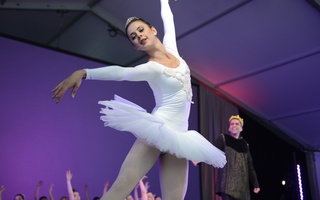Sitting in on a rehearsal with new Harvard Dance Program lecturer Mario A. Zambrano, the only thing more striking than his expertise is the easy rapport he has with his students. Zambrano is a former member of Batsheva Dance Company and a published novelist. He’s also danced with Ballet Frankfurt, Nederlands Dans Theater, and Hubbard Street Dance Chicago. An award-winning artist, Zambrano teaches two new for-credit courses this semester, “Deconstructing a Novel into Dance,” and “GAGA: Movement Language Created by Ohad Naharin.” The Crimson sat down with him to learn about his career and new role at Harvard.
The Harvard Crimson: When did you begin your dance career and when did you decide that you wanted to dance professionally?
Mario A. Zambrano: I’m Mexican, and I grew up in Houston, and part of my Mexican upbringing [was] attending a lot of Mexican weddings and quinceañeras … [My mom] would just always pull me out to dance with her. In those moments all I remember is having such a good time and seeing everyone around me on the dance floor sort of stand back and cheer me on. If you feel that kind of love, that immediacy of love and attention and support and encouragement, you just want to experience it again. I started taking dance when I was ten.
THC: How did you begin your professional training as a dancer?
MAZ: I went to the Houston Ballet Academy, and I got very serious, and then I found the High School for the Performing and Visual Arts. I was very busy, but I loved it. By chance there was a contemporary dance company from Chicago that was performing in Houston. They were called Hubbard Street Dance Chicago. I took a class with the company and then I auditioned. Afterward, I was 16, the director took me aside … and he was like, ‘I’d hire you right now but you’re in school!’ I was very excited about that, and torn, because I wanted to stay for the Houston Ballet, but also in that year I got a full scholarship to Juilliard. In the end, at 17, I began my dance career.
THC: How did you get into writing?
MAZ: I ended up going back to school. [I was] looking for something I could love equally as much as I did dancing. I started seeing [books] as … full-length, choreographic works, but with language, and that really pulled my attention. And then when I started taking it seriously, I went to the New School, and then I applied for MFA programs. I realized how difficult it was to become a writer, so when I got into Iowa, and then I got an agent, and I got a publisher, it was a big surprise. Big, big surprise.
THC: How did you end up here at Harvard?
MAZ: After I graduated and published [“Lotería"], I was very lucky to have been given the opportunity to be a full-time writer, which was the dream during those eight years of going to school. People [from the dance world] were always asking me to teach or to come choreograph and while I was studying I told them ‘No, I’m not interested, I’m a writer now,’ but now … I started saying ‘Yes, I will come teach, I will come choreograph.’ And I began to love it again in a different way.
THC: How did your novel affect the course that you’re teaching now, “Deconstructing a Novel into a Dance”?
MAZ: During my graduate studies, a lot of what we did was talk about structure and how novels are composed and put together, and because I’ve always had this affinity to see them as choreographic works, I thought it would be really interesting to bridge these two disciplines [for] students who would be interested in choreography and also literature. We study [three] novels, how they’re put together, their point of view, the thematic … patterns that come up. We talk about architectural interpretation as well—what the book would look like as a building or as a venue. We talk about music. We talk about light. And then we go into the studio and start working with modalities to create movement that will complement … how they want to interpret the novel in the final project, which is a choreographic score of a particular book. So far it’s going well.
Read more in Arts
Despite Pre-Release Concerns, ‘Mass Effect: Andromeda’ Is Worth PlayingRecommended Articles
-
Etheriality vs. the SensesD ANCE IS AN ART built on tensions. From the primary element of the working muscle to the elegant patterns
-
Male Dancers Prominently Featured in BalletBoston Ballet's Fall Program highlights its male talent.
-
 “Duetti” Explores Duality of Movement and Relationships
“Duetti” Explores Duality of Movement and Relationships -
 Arts First Features More Than 100 Live Performances
Arts First Features More Than 100 Live Performances -
‘Punk Ballerina’ Karol Armitage Discusses Dance and ArtChoreographer and “punk ballerina” Karole Armitage discussed the meaning behind dance and its connection to other realms of life in a talk entitled “Naked Body Language” at the Radcliffe Institute for Advanced Study Monday afternoon.













